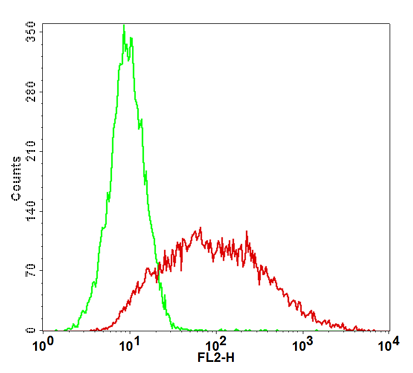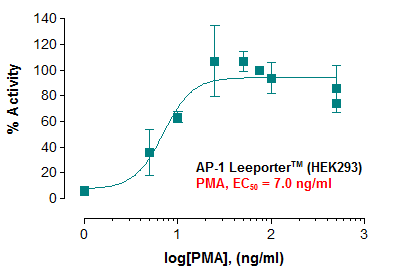Recombinant Human Visfatin(Discontinued)
Shipping Info:
For estimated delivery dates, please contact us at [email protected]
| Amount : | 25 µg |
| Purification : | Purity: >= 98% by SDS-PAGE gel and HPLC analyses. |
| AA sequence : | MPPNTSKVYS YFECREKKTE NSKLRKVKYE ETVFYGLQYI LNKYLKGKVV TKEKIQEAKD VYKEHFQDDV FNEKGWNYIL EKYDGHLPIE IKAVPEGFVI PRGNVLFTVE NTDPECYWLT NWIETILVQS WYPITVATNS REQKKILAKY LLETSGNLDG LEYKLHDFGY RGVSSQETAG IGASAHLVNF KGTDTVAGLA LIKKYYGTKD PVPGYSVPAA EHSTITAWGK DHEKDAFEHI VTQFSSVPVS VVSDSYDIYN ACEKIWGEDL RHLIVSRSTQ APLIIRPDSG NPLDTVLKVL EILGKKFPVT ENSKGYKLLP PYLRVIQGDG VDINTLQEIV EGMKQKMWSI ENIAFGSGGG LLQKLTRDLL NCSFKCSYVV TNGLGINVFK DPVADPNKRS KKGRLSLHRT PAGNFVTLEE GKGDLEEYGQ DLLHTVFKNG KVTKSYSFDE IRKNAQLNIE LEAAHH |
| Alternative Name : | PBEF (Pre-B cell colony-enhancing factor), NAmPRTase (nicotinamide phosphoribosyltransferase), Nampt, VF |
Source:E.coli
Visfatin is a 55 kDa protein produced and secreted primarily by white adipose tissue. Recently, visfatin was isolated from visceral fat deposits and shown to possess insulin-mimetic activity. Like insulin, visfatin exerts hypoglycemic effects by interacting with the insulin receptor. The binding affinity of visfatin for the insulin receptor is similar to that of insulin, but it does not compete with insulin, suggesting that the two proteins interact with different receptor sites. The circulating levels of visfatin are much lower than those of insulin and are not affected by feeding, implying that the hypoglycemic effect of visfatin may not be of physiological importance. The plasma visfatin levels, like those of leptin, correlate positively with the percent of body fat, and increase during the development of obesity. Another similarity between visfatin and leptin is that their amino acid sequence is highly conserved across different mammalian species and shows no homology to any known protein. Receptors for both leptin (Ob-R) and visfatin (i.e. the insulin receptor) are expressed by neurons within the arcuate nucleus of the hypothalamus, a brain area that plays a pivotal role in the regulation of energy metabolism. Although the metabolic function of visfatin is still unknown, it appears that this newly identified adipocytokine might play an important role, similar to that of leptin, in the regulation of body weight, i.e. as an afferent signal reflecting excess body fat. The PBEF gene encodes a polypeptide of 491 amino acid residues. The secreted form of this polypeptide, i.e. visfatin, contains 465 residues and lacks the first 26 N-terminal residues of the PBEF gene product. The 491-residue form has been shown to be a nicotinamide phosphoribosyltransferase, a cytosolic enzyme involved in NAD biosynthesis. The amino acid sequence of visfatin is highly conserved across different species and shows no homology to any known protein. It contains 5 cysteine residues, of which only two of them appear to be involved in disulfide bridge formation. Recombinant human Visfatin is a 52.6 kDa protein containing 466 amino acid residues (isoform 1).
Visfatin is a 55 kDa protein produced and secreted primarily by white adipose tissue. Recently, visfatin was isolated from visceral fat deposits and shown to possess insulin-mimetic activity. Like insulin, visfatin exerts hypoglycemic effects by interacting with the insulin receptor. The binding affinity of visfatin for the insulin receptor is similar to that of insulin, but it does not compete with insulin, suggesting that the two proteins interact with different receptor sites. The circulating levels of visfatin are much lower than those of insulin and are not affected by feeding, implying that the hypoglycemic effect of visfatin may not be of physiological importance. The plasma visfatin levels, like those of leptin, correlate positively with the percent of body fat, and increase during the development of obesity. Another similarity between visfatin and leptin is that their amino acid sequence is highly conserved across different mammalian species and shows no homology to any known protein. Receptors for both leptin (Ob-R) and visfatin (i.e. the insulin receptor) are expressed by neurons within the arcuate nucleus of the hypothalamus, a brain area that plays a pivotal role in the regulation of energy metabolism. Although the metabolic function of visfatin is still unknown, it appears that this newly identified adipocytokine might play an important role, similar to that of leptin, in the regulation of body weight, i.e. as an afferent signal reflecting excess body fat. The PBEF gene encodes a polypeptide of 491 amino acid residues. The secreted form of this polypeptide, i.e. visfatin, contains 465 residues and lacks the first 26 N-terminal residues of the PBEF gene product. The 491-residue form has been shown to be a nicotinamide phosphoribosyltransferase, a cytosolic enzyme involved in NAD biosynthesis. The amino acid sequence of visfatin is highly conserved across different species and shows no homology to any known protein. It contains 5 cysteine residues, of which only two of them appear to be involved in disulfide bridge formation. Recombinant human Visfatin is a 52.6 kDa protein containing 466 amino acid residues (isoform 1).
The ED50 ?was determined by the dose-dependent proliferation of the RPMI 8226 cells. The expected ED50 ?for this effect is 15.0-20.0 ng/ml.Â
For Research Use Only. Not for use in diagnostic/therapeutics procedures.
|
There are currently no product reviews
|





















.png)










